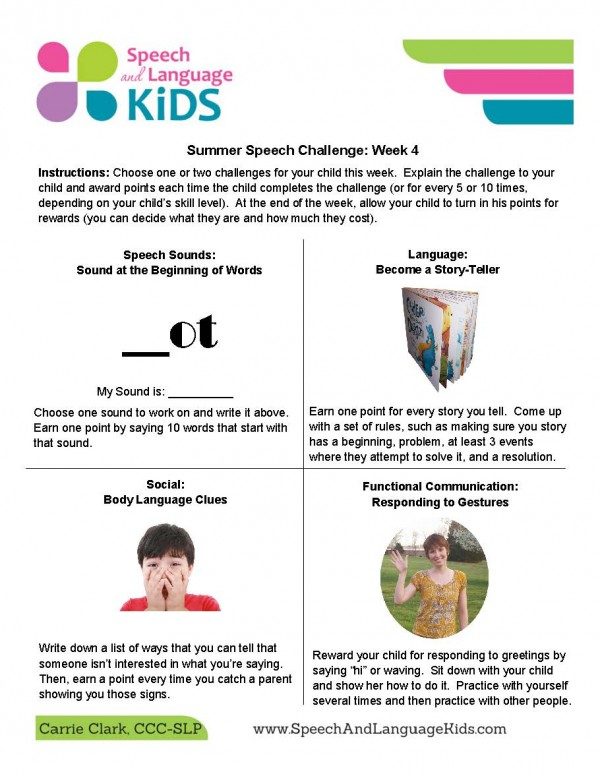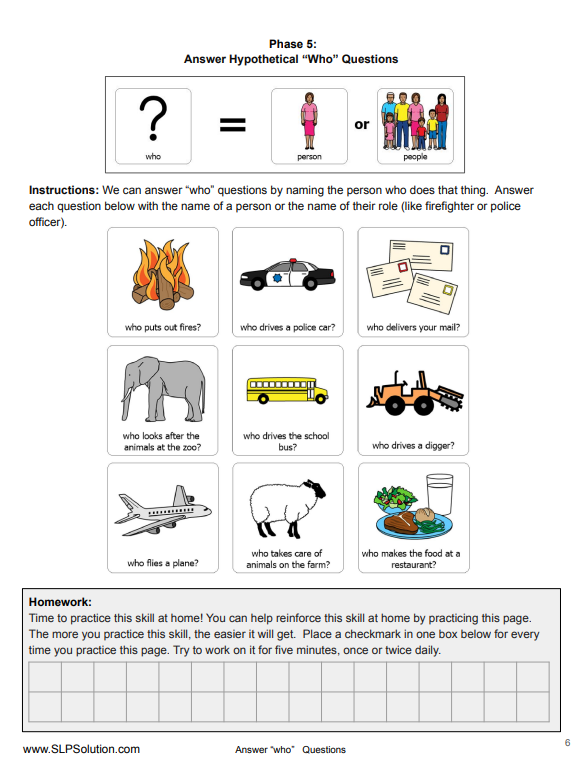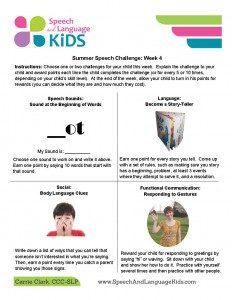Summer Speech Therapy Homework – Week 4
Welcome to week four of our Summer Speech Challenge for Parents! Click here if you want to go back and start from week 1!
Summer Speech Therapy Homework Challenge:
To recap, our Summer Speech Challenge is a new challenge for your child each week of this summer. These are simple activities that are meant for you to be able to work into your daily routines. There are four different challenges each week so you can pick which one is best for your child. If you feel like your child struggled with last week’s and you’d like to try it for another week, go for it! Or, you can push ahead and do this week’s activity anyway. Sometimes our children do better if we switch to something else.
Avoid the Battle:
I want to make a quick note here that nothing we’re doing here should be a battle! If your child is struggling to do the skill that you’ve selected, try to either make it easier or switch to something else. The reason that we speech-language pathologists go to school for 5+ years is so that we can know exactly how to tweak things when the child isn’t getting it. So don’t feel bad if it’s just not clicking for you and your child! Switch to something a little easier to keep the momentum going and check in with your child’s speech-language pathologist. This shouldn’t replace the advice of a licensed speech-language pathologist!
Choose an Area:
You’ll want to pick one or two challenges for your child to work on this week. Here’s a quick breakdown of the 4 areas that are included in our summer challenge so you can pick which skills your child needs.
- Speech Sounds: Choose this area if your child is struggling to say a sound correctly in conversation. You’ll only choose one sound to work on at a time so don’t go crazy! You can always come back and repeat this process with another sound later.
- Language: Choose this area if your child struggles with any parts of language. This can include anything from using full, grammatically-correct sentences to knowing the names for different vocabulary words. If it has to do with putting together sentences and getting your ideas across using words, then language is your area.
- Social Skills: Choose this area if your child needs help with interacting appropriately with others. We’ll practice a variety of interaction skills with this area.
- Functional Communication: Choose this area if your child is just beginning to talk or is only saying 1-2 words at a time. This area will focus on basic communication skills for our non-verbal children and new talkers.
Challenge Week 4:
Let’s get started with this week’s challenge! I’ll be posting a new challenge each week, so make sure you subscribe to our email list so you don’t miss a week! You can also follow us on social media at The SLP Solution.
Instructions:
- Choose one (or max two) areas below that your child needs to work on
- Print out the visuals for the challenges and cut out the ones your child needs
- Post the visuals somewhere so you and your child will see it frequently
- Read the challenge rules and explain it to your child in language she will understand
- Award points as your child completes the challenge throughout the week (view week 1 for ideas for this)
- Allow your child to redeem points as you see fit
Week 4 Picture Download:
Click Here to Download the PDF
The Challenges:
Speech Sounds: Sound at the Beginning of Words
For the speech summer challenges, you’ll want to choose one sound to work on. It gets complicated when you start adding in multiple sounds so just choose one that your child needs to work on. It can be one he’s already been working on in speech or an entirely new one.
So far this summer, you’ve practiced saying that sound by itself (in isolation) and in nonsense syllables (fee, fi, fo fum). If your child has done well with that, you can move on to this challenge. If not, stay on the previous step for a while or switch to a new sound that your child may find a little easier. This one may require a little more one-on-one work with a speech-language pathologist before your child is ready to practice it at home.
For this week’s challenge, your child gets a challenge point for saying their sound at the beginning of words. I suggest offering points after your child says 10 words that start with the sound. At first, have your child repeat words after you that start with this sound. Repeating a word is easier than saying it spontaneously. Instruct your child to watch your mouth so he can see how you make the first sound. Your child may need you to over-exaggerate the sound at the beginning in order to hear it correctly. Help your child remember where to put his tongue and mouth in order to say the sound correctly.
If this is hard for your child, go back to a few nonsense syllables and then try moving back into the actual word. You can have the child build it up sound by sound, as well. For example, if the word is “cat”, you can have him say “c…ca….cat”.
Once your child can imitate you saying words that start with the target sound, have your child think of words to say on his own. If he can’t think of any, get out a book or your phone and pull up pictures of things that start with the sound. Have him look at the picture and tell you what it is called.
Why This Helps: Here’s where it gets kind of tricky. If your child can already say the sound by itself and in nonsense syllables, he may struggle a bit more when we go to put it in real words. That’s because these words have a specific meaning and his brain has already associated the wrong sound with that meaning. You’ll need to help him break this down and add the correct sound so that his brain can continue to rework the pathways to producing this sound.
Language: Become a Story-Teller
Telling stories is a great activity for children who are struggling to learn language skills because so many different aspects of language go into them! For this week’s challenge, your child can earn one point every time she tells you a story. The length and detail required in the story will depend on your child’s age and language level.
Come up with a set of rules that will be required for your child’s story to count for a challenge point. For younger children, you only need to require that their story has a beginning (“Once upon a time…”), a middle (“Then…”), and an end (“Finally…”). They don’t have to make a ton of sense, we just want to make sure they understand beginning, middle, and end.
As we work our way up toward older children, we expect them to get more and more components of story-telling included. The basic story framework would include a beginning (introduce the characters and setting), a problem (what went wrong), three events (how did they try to solve the problem), and a resolution (how did they fix the problem). For older children, write down those four elements and help them come up with ideas for each one.
If your child is struggling with this, try giving her some ideas to get her started. Tell her who is in the story and where they are and what the problem is. Then, have your child come up with some events of things they might do to fix the problem. As your child gets better at this, have her come up with a few characters and you’ll come up with the problem, or vice versa! You can also have your child start by retelling familiar stories like fairy tales that she already knows.
Why This Helps: Story-telling helps us with many language skills. We’re able to work on sequencing and organization while using our grammatical skills to put together complete sentences. It also helps with literacy skills that will translate over into improved comprehension when reading stories in the future.
Social Skills: Body Language Clues
Sometimes our children with social skills delays may not be very good at reading other people’s body language. Has your child ever missed a cue that someone else wasn’t interested in listening to him go on and on about his favorite subject? If so, this challenge is for him!
This week, let’s learn about how to tell if someone’s body language says they’re not interested. I specifically chose this type of body language clues because many of our children with social language impairments think that everyone else is just as excited about their favorite topic as they are. But that’s not always the case.
Sit down with your child an explain that we can watch other people’s bodies to know when they aren’t interested in what we’re talking about. Brainstorm a list of clues that you can look for and write them down with your child. Ask your child to come up with some ideas. If he doesn’t have any, you can suggest some yourself. Here’s our list:
- Turning their body away
- Looking elsewhere (like they’re trying to find a way out)
- Saying “uh huh” or nodding but not really adding to the conversation
- Saying things like “I better go” or “I have something to do”
- Walking away
Once you’ve come up with the list, tell your child that he can earn a challenge point every time he catches you showing those signs. Then, throughout the week, practice by intentionally showing these signs that you’re not interested and see if he notices. At first, you’ll probably have to point out what you’re doing. But the more you do this, the better he should be at catching it.
It may seem mean or cold-hearted to intentionally make your child feel like you’re not interested, but keep in mind that it’s better for him to get this lesson from you than to miss a cue in a social situation and risk potential embarrassment when his peer doesn’t approach it so gently. After you help your child see that you were showing those signs, you can go back and say something like “I was just helping you practice, but I do really want to hear about what you were saying. Tell me again and this time I’ll listen”.
Why This Helps: Kids can be mean. There’s no getting around that. And the children who miss social cues tend to get the brunt of it. But, we can help our children who struggle with social cues by specifically telling them what to look for and what to do. This will help your child fit in better with his peers while helping him avoid potentially embarrassing situations where someone calls him out for it or excludes him from an event because of his poor social skills.
Functional Communication: Responding to Greetings
Hi! How are you? Greetings occur in our lives every day and they are an important part of social interactions. Children who are late to talk may not understand how these greetings work and may need a little bit of help to get going.
This week, reward your child when she responds to a greeting. Adjust this challenge to your child’s language skills level. If your child isn’t talking, she can respond to greetings by waving. If your child is talking, come up with a few easy things she can say to respond to a greeting, such as “hi”.
To start, sit down with your child and choose a reward that she really likes. This can be a favorite food, activity, or toy. Let her have the reward for just a little bit and then take it away (or put the rest out of reach). Tell your child, “let’s practice saying hi”. Then, say hi to your child and wave. Make sure you have her attention when you do it. Then, pick up your child’s hand and help her wave. Tell her, “Say hi” while you help her wave her hand. If she says “hi”, awesome! If not, that’s OK too! You’re helping her learn. Then, offer her a little bit of the reward.
Keep repeating this process. Say “hi” and wave and then encourage your child to do the same. Do this for several minutes to help her get the idea. You can keep doing these practice sessions or you can simply help her respond throughout her day when people greet her. You can take her out to the grocery store or park to practice, or just recruit friends and family to say hi to her when they see her so she can practice more. Make sure to offer a reward when she says hi, even if that’s just a hug and saying “good job, you said hi”!
Why This Helps: Greetings are the socially agreed-upon way to start an interaction. Once someone responds to our greeting, we take that as permission to continue talking to that person. If someone greets your child and your child doesn’t respond, that person is less likely to continue talking to your child. Which means fewer opportunities for her to practice speaking. But if she does say “hi” back, that other person may speak with her more and give her more opportunities to talk. And the more she practices, the better she’ll get!
Recap:
OK, you should have your challenge(s) by now. Here’s a recap of what you need to do:
- Print out the pictures for this week’s challenges and cut out the ones you need (see button below)
- Post the challenge picture on the wall and explain the challenge to your child
- Award points throughout the week whenever your child completes the challenge
- Encourage your child to practice and earn points as often as possible

About the Author: Carrie Clark, MA CCC-SLP
Hi, I’m Carrie! I’m a speech-language pathologist from Columbia, Missouri, USA. I’ve worked with children and teenagers of all ages in schools, preschools, and even my own private practice. I love digging through the research on speech and language topics and breaking it down into step-by-step plans for my followers. I graduated from Truman State University in Kirksville, MO with a masters degree in Communication Disorders.
Connect with Me:









Your article was very beautiful, and very informative.
Great Blog.
Adjust this challenge to your child’s language skills level. If your child isn’t talking, she can respond to greetings by waving.